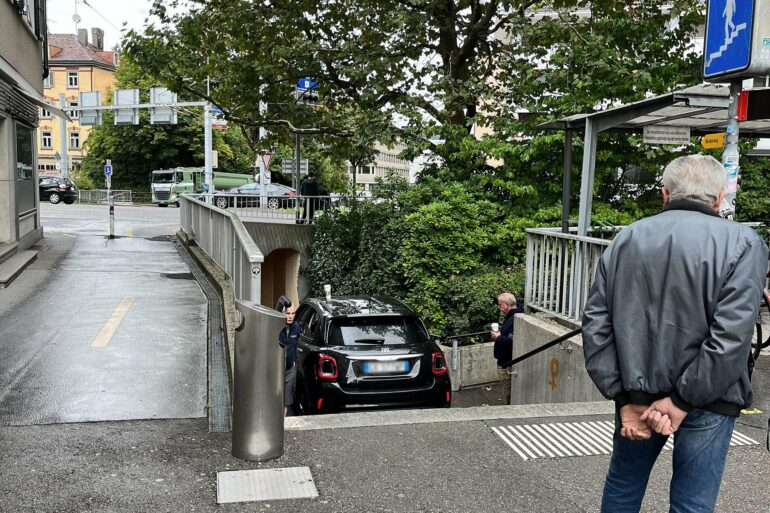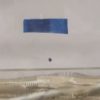Blindly following GPS navigation can lead to difficult situations on the road. A research team has analyzed such incidents and is in favor of delegating more personal responsibility to drivers.
San Bernardino, every year at Easter: Holiday traffic causes congestion on the A13. Navigation systems redirect the stream of cars into the surrounding villages. For locals, there is no getting through.
Herisau, hiking trail: In search of a residential street, cars and delivery trucks constantly end up stranded on a steep gravel road that is closed to vehicles. This leads to risky turning maneuvers, as residents report to SRF. Drivers blindly follow GPS instructions instead of paying attention to signs.
Zurich, UCI Road Cycling World Championships 2024: A large number of road closures and diversions result in traffic chaos. According to the city police, incorrect route suggestions by Google Maps are partly to blame.
As useful as GPS-controlled navigation systems are in everyday life, they often lead people astray and trigger outrage. Sometimes they even guide cars and lorries onto very challenging roads, unnecessarily endangering everyone involved.
“This is a technology that is used by more than a billion people worldwide. That’s why it’s important to understand the social implications,” explains postdoc Gian-Luca Savino. He is conducting research into human-technology interaction led by Johannes Schöning.
Since there is no publicly available documentation, the researchers used a different method: they systematically combed the LexisNexis news database for newspaper articles and internet posts about incidents in which navigation systems caused chaos and problems. To avoid complications due to translations, they only looked at English texts, which unsurprisingly reported mostly on events in English-speaking countries. But as the examples above illustrate, such incidents also occur in Switzerland.
“A search like this gives you a very good indication of how certain phenomena are perceived in society,” says Ph.D. student and first author Eve Schade. “In societies where navigation apps are increasingly used, we can expect to see more of these types of situations in the future.”
The research is published in the journal PLOS ONE.
Traffic disruptions and safety hazards
In total, they identified ninety incidents between 2010 and 2023. The team then conducted a systematic content analysis of the articles to categorize the problems mentioned: half of the traffic disruptions reported were traffic jams, while a third were caused by through traffic of heavy vehicles, especially on roads that were not designed for such volumes of traffic.
Reports of traffic rule violations and disturbances to residents were less common. The latter were caused, for example, by long lines of cars preventing drivers from being able to back out of their private parking spaces.
The safety hazards mentioned in the newspaper reports concerned accidents in a third of cases, but also damage to road surfaces. “We were surprised by how often the issue of additional air pollution was raised,” notes Savino. “This is also relevant to safety because it can impact health.”
Through studies such as this one, the team not only wants to categorize the problems perceived by society, but also develop solutions. “The evaluation showed that in most cases, the aim is only to make adjustments at the local level,” observes Savino. For example, residential streets were closed to through traffic or turning was prohibited at certain points. Some apps also allow users to report errors.
However, these are not effective long-term solutions—they just shift the problem elsewhere. “Cars might disappear from one neighborhood, but then they reappear in the next,” states Savino.
Letting people decide for themselves
For this reason, more systematic ideas are needed, for instance, an adaptation of the algorithms used by providers such as Google Maps. However, the team also has another suggestion that does not completely delegate responsibility to technology: the system could provide users with additional information about the suggested routes—and then let them choose for themselves.
“A lorry driver could then, for example, consider whether he prefers to barrel through a quiet residential area at high speed or spend extra ten minutes in a traffic jam,” says Schade. At the moment, route calculation by navigation systems is based solely on the driver gaining time. Aspects such as environmental impact or possible safety risks are not taken into account. “It would be nice if people could voluntarily choose to be more considerate.”
More information:
Eve Schade et al, Traffic jam by GPS: A systematic analysis of the negative social externalities of large-scale navigation technologies, PLOS ONE (2024). DOI: 10.1371/journal.pone.0308260
Provided by
Swiss National Science Foundation
Citation:
Preventing GPS-caused traffic chaos: Study supports delegating more personal responsibility to drivers (2024, October 29)



